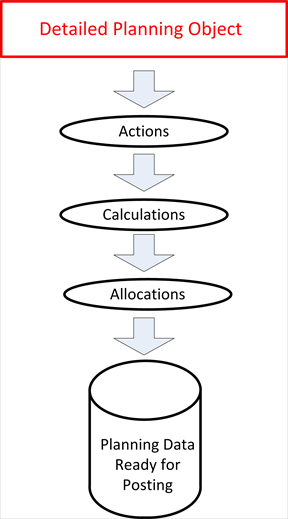Allocations and the DPO
What are allocations? Allocations distribute calculation data to other target Organization (Geography) members and/or target accounts in the financial model.
Example: In personnel planning it is common for an IT department to employ staff who are loaned to other departments or projects; allocations make it possible to distribute a percentage of the calculated costs across departments.
When are allocations run? Allocations are one of the three objects that affect how the data belonging to a Detailed Planning Object (DPO) is processed, and come last in the order of execution:

Where are allocations defined? Allocations, like calculations, are defined at the model level so that they can be shared among all the DPOs as needed. Allocations are also defined by scenario to accommodate what-if analysis and forecasting requirements, where different allocation assumptions need to be tested.
Can conditions be set for an allocation? An allocation can be made conditional, so that it applies only to selected DPOs, based on attribute values.
How is the allocation percentage set? The percentage used in an allocation can be a user-specified value, an attribute of the DPO, or an input calculation that varies not only by DPO but also by time.
Where are allocations posted? When allocations are used, the allocated data is posted to special members of the Allocations dimension in the detailed planning model. It is posted to the Allocated Out member of the Organizational entity that is performing the allocation and the Allocated In member for the Organizational entity that is receiving the allocation.
Adjustable allocations
What are adjustable allocations? The parameters of an allocation can be specified as adjustable. This means that all users with appropriate data security access can edit those parameters for individual DPOs.
Example: In personnel planning, the administrator can specify that 25% of the costs associated with an employee will be allocated to a specific project, but the employee's manager can still modify this percentage.
Discretionary allocations
Must an allocation apply to all members? No. You can make an allocation discretionary; users with appropriate permission can then decide whether the allocation applies to a given DPO. Discretionary allocations work much the same as discretionary calculations.
What are non-discretionary allocations? These are allocations that apply to all DPOs that meet the defined conditions.
Allocation reporting
How flexible is allocation reporting? You can start at the organizational level, but also analyze the allocations further by drilling down to the level of job title or even employee. The following table provides an example of a simple allocation report:
| Total Employment Costs — 2025 Planned Allocations | ||||
|---|---|---|---|---|
| Source | Allocated Out | Allocated In | Post-Allocation | |
|
Info Tech |
500,000 |
(400,000) |
50,000 |
150,000 |
|
Human Resources |
150,000 |
(150,000) |
|
|
|
Finance |
300,000 |
|
100,000 |
400,000 |
|
Sales and Marketing |
600,000 |
|
400,000 |
1,000,000 |
|
Total: |
1,550,000 |
(550,000) |
550,000 |
1,550,000 |